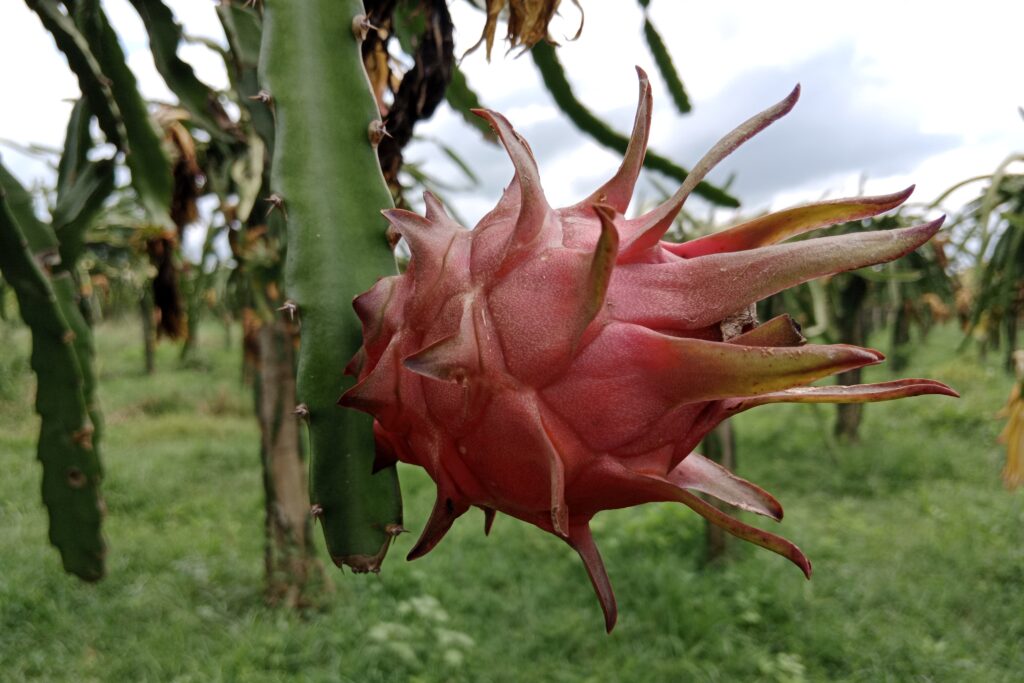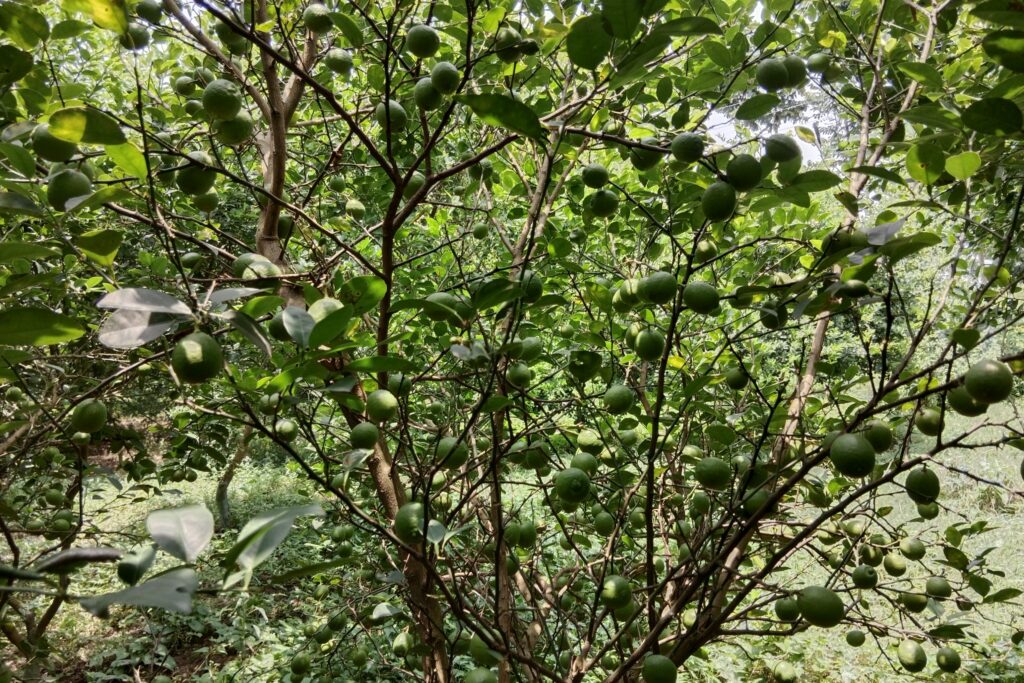Fava Bean Farming
Fava bean (Vicia faba), also known as broad bean, is a cool-season legume widely cultivated for its nutritious seeds and pods, which are consumed both fresh and dried. Renowned for its high protein content and soil-enriching nitrogen-fixing ability, it plays a dual role in human nutrition and sustainable agriculture. Adaptable to diverse climates and soils, fava bean is valued in crop rotations, livestock feed, and food systems across the globe.
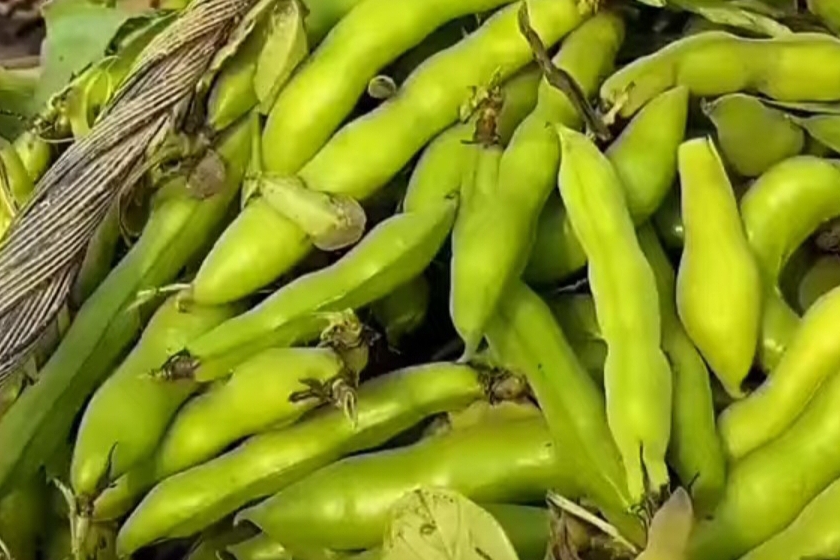
An analysis of Fava bean farming profit per acre reveals a highly lucrative agricultural venture. Based on the key financial metrics, the total income generated per acre is a substantial NRs. 240,000. When measured against a total investment cost of NRs. 52,000, this results in a remarkable net profit of NRs. 188,000, simply calculated by subtracting the total costs from the gross income. Consequently, the operation yields a robust profit margin of 78.3%, a figure determined by the standard formula (Net Profit / Total Income) * 100, underscoring its significant potential for profitability.
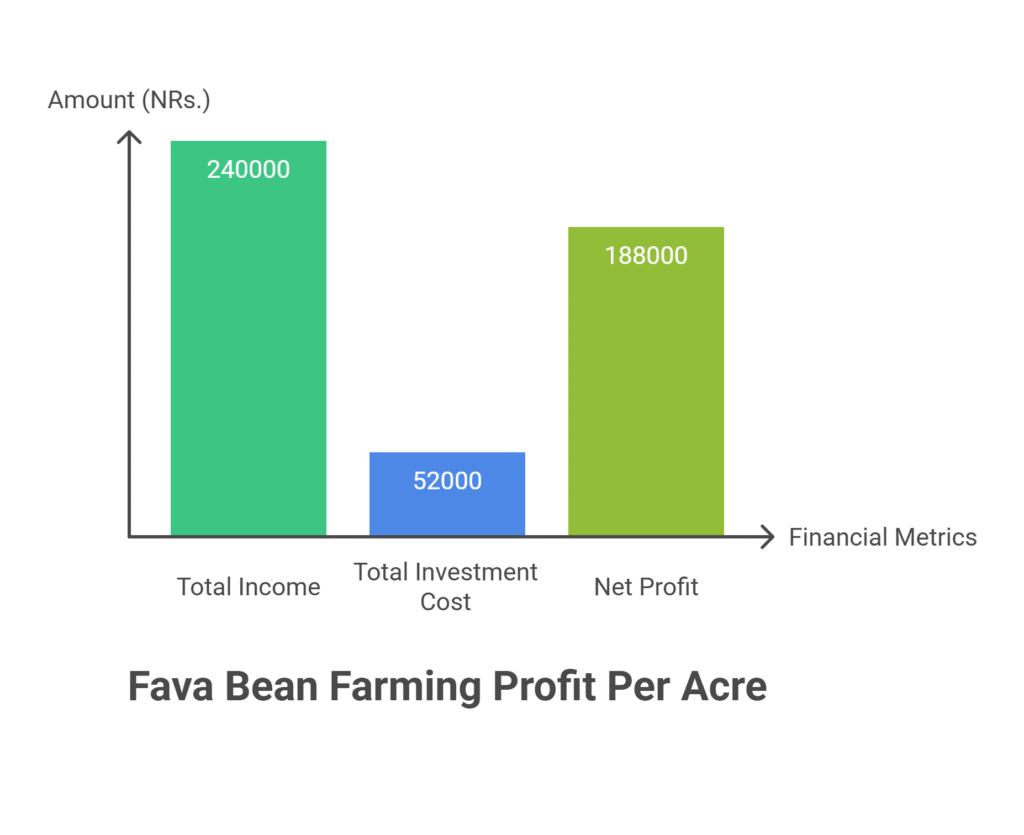
Land Preparation
Proper land preparation is essential for ensuring good germination and healthy root development in fava beans. The process begins with primary tillage, involving deep plowing to a depth of 20–25 cm (8–10 inches) to break compacted soil layers, which enhances root penetration, soil aeration, and drainage.
This is followed by secondary tillage with 2–3 rounds of harrowing or discing to break down large soil clods and create a fine, level seedbed. Weeds, stones, and crop residues should be cleared to minimize competition and avoid hindrances to field operations. In poorly drained areas, forming raised beds or ridges is recommended to prevent waterlogging, as fava beans are particularly sensitive to excess moisture.
Soil Type
Fava beans grow best in deep, well-drained loamy soils rich in organic matter, with an optimal pH range of 6.0 to 7.5, favoring neutral to slightly alkaline conditions. While they are more tolerant of heavier clay soils compared to most other beans, they perform poorly in highly acidic environments. Good drainage is essential, as waterlogged conditions can quickly cause root rot and promote fungal diseases.
Climatic Requirements
This cool-season crop thrives in temperatures between 15°C and 22°C (59°F and 72°F). However, strong frost can harm blooms and immature pods. During the seedling and vegetative stages, they can resist temperatures as low as -5°C (23°F).
The optimal circumstances are moderate humidity because high humidity and rainfall raise the danger of fungal illnesses like chocolate spot. Sufficient rainfall during flowering can hinder pollination and lower output, but consistent soil moisture is essential throughout the growth season, especially during flowering and pod development.
Major Cultivars
| Cultivar Type | Key Characteristics | Examples |
| Windsor Types | Large-seeded, popular for fresh market and home gardening. | Windsor, Green Windsor |
| Longpod Types | High-yielding, hardy, produce pods with more beans. Includes early and dwarf varieties. | Aquadulce Claudia (early), The Sutton (dwarf) |
| Field Bean Types | Smaller-seeded, mainly grown for dried bean production or animal feed. | Tick, Ticbeans |
| Modern Hybrids | Bred for commercial production, many with strong disease resistance. | Fuego (resistant to chocolate spot) |
Propagation
Fava beans are propagated almost exclusively by seed. They are direct-seeded; transplanting is not common due to their sensitive taproot.
Seed Rate per Acre
The seed rate for fava beans varies depending on seed size, desired plant density, and the planting method used, with the typical requirement ranging between 70 and 90 kg per acre.
Planting
a). Planting Season
In regions with mild winters, fava beans are best planted in late autumn or early winter, allowing the plants to establish during the cooler months and provide an early spring harvest while avoiding the stress of summer heat.
b). Spacing
For optimal growth, fava beans should be spaced 60 to 90 cm apart between rows and 15 to 25 cm between individual plants within each row.
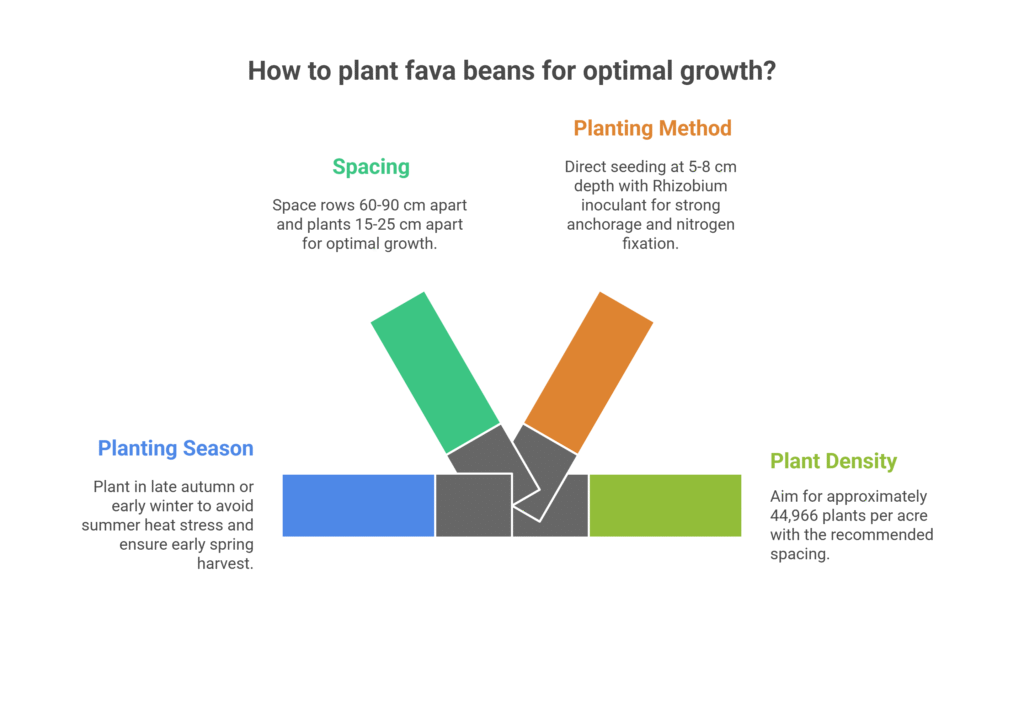
c). Planting Method
Fava beans are typically established through direct seeding, either by hand or with a mechanical planter, with seeds sown 5 to 8 cm (2 to 3 inches) deep to protect them from birds and ensure strong anchorage. Prior to planting, seeds should be treated with a Rhizobium leguminosarum inoculant to promote effective nitrogen fixation, thereby reducing the need for additional nitrogen fertilizer.
d). Number of Plants per Acre
With a spacing of 60cm x 15cm, the plant population would be approximately 44,966 plants per acre.
Intercropping
Fava beans are well-suited for intercropping because of their nitrogen-fixing ability, making them valuable partners for heavy feeders such as maize, squash, or potatoes. When intercropped, they not only enrich the soil with nitrogen but also help suppress weeds through their canopy cover while optimizing land use efficiency.
Irrigation
Fava beans require irrigation, especially during germination, flowering, and pod formation. It is better to use drip or furrow irrigation rather than overhead sprinklers to keep the leaves dry and lower the chance of illness. After planting, water deeply. If rainfall is insufficient, then water around 1 inch per week. As pods get older, water less frequently to promote appropriate drying.
Fertilizer and Manure
| Application Type | Recommendation | Purpose / Remarks |
| Basal Application | 10-15 tons of well-decomposed FYM or compost per acre. | Improve soil structure. Applied before planting. |
| Biofertilizer | Azospirillum + PSB + Potash mobilizing Bacteria (each 800g per acre). | Promote nitrogen fixation and nutrient mobilization. |
| Phosphorus (P₂O₅) | 50-60 kg per acre (adjust based on soil test). | Applied at the time of planting. |
| Potassium (K₂O) | 40-50 kg per acre (adjust based on soil test). | Applied at the time of planting. |
| Nitrogen (N) | 20 kg per acre as a starter dose. | Minimal amount required. Excess nitrogen promotes foliage over pod growth and increases disease susceptibility. |
Weed Control
Weed control in fava beans is most critical during the first 4–6 weeks after sowing. Effective mechanical control includes shallow cultivation or hoeing between rows, taking care not to damage the shallow roots. While pre-emergence herbicides can be used, post-emergence chemical options are limited due to the crop’s sensitivity, so it is important to follow label instructions carefully. Additionally, applying organic mulch such as straw or hay helps suppress weeds and conserve soil moisture.
Inter culture operation
Training is generally not necessary for determinate or dwarf fava bean varieties. However, for tall, indeterminate types grown in windy areas, staking or using a support system such as a trellis can prevent lodging. Pruning or pinching the top 5–7 cm (2–3 inches) of the main stem after the first few sets of flowers have formed is a common practice, as it redirects the plant’s energy toward pod development, helps deter black aphids attracted to tender growth, and improves air circulation.
Flowering and Fruit Management
Fava beans are self-fertile, but pollination is largely carried out by bumblebees and other native bees, so encouraging pollinators near the field can greatly enhance pod set and overall yield. However, not all flowers develop into pods, and environmental stresses such as heat, drought, or waterlogging during flowering can lead to significant flower drop, affecting fruit set.
Pest and Disease Management
a) Black Bean Aphid (Aphis fabae)
The most serious fava bean pest is black bean aphids, which gather on fragile growth and new stems. They may result in reduced production and stunted growth. Management options include employing insecticidal soaps, physically clipping out severely infested tips, and promoting natural predators like ladybugs and lacewings.
If chemical control is required, carefully follow the label’s directions and apply an approved systemic insecticide, such as imidacloprid 0.3–0.5 g per liter of water, or a contact insecticide, such as lambda-cyhalothrin 0.5 ml per liter.
b) Stem Nematode (Ditylenchus dipsaci)
Stem nematodes cause stunted plants with swollen, cracked stems, which can lead to severe yield loss. The best management practices are long crop rotations of 5–7 years and planting clean, certified seeds. There are no effective chemical nematicides for small-scale application, so prevention through crop hygiene is key.
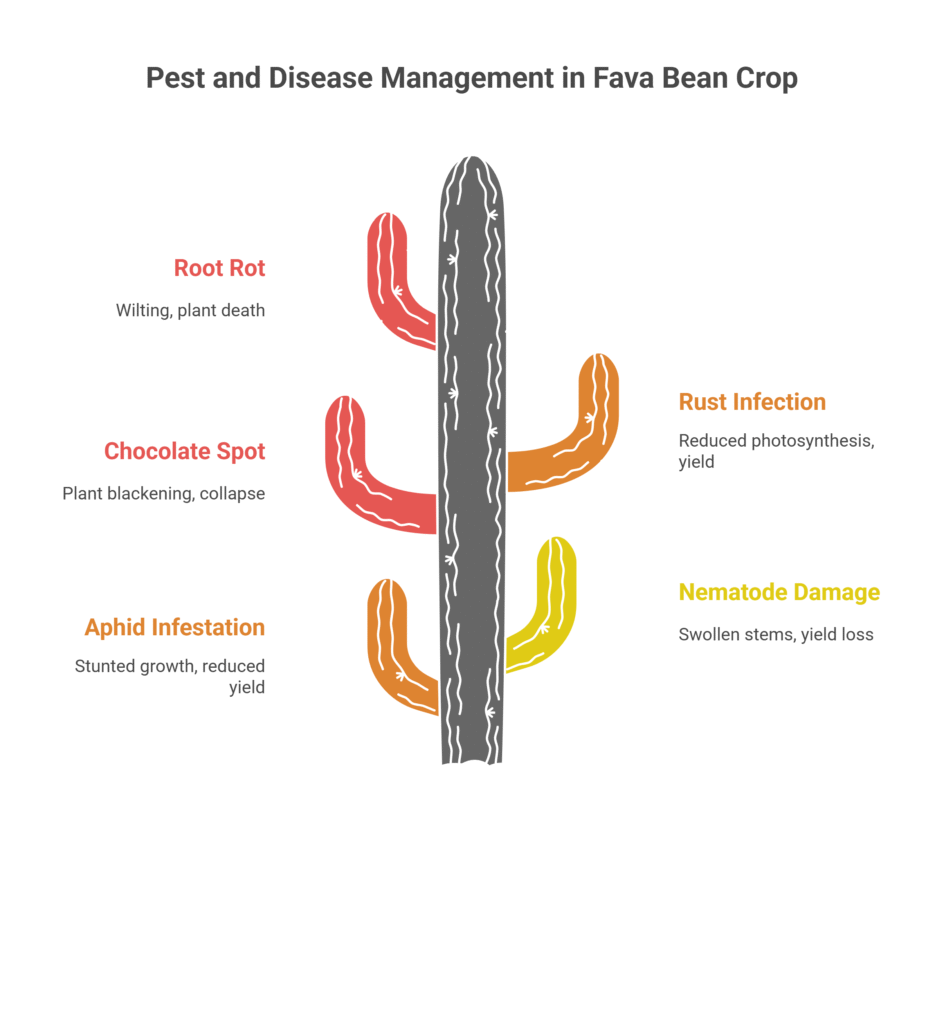
c) Chocolate Spot (Botrytis fabae & B. cinerea)
Chocolate spot is one of the most devastating fava bean diseases, appearing as small reddish-brown spots on leaves and stems that may merge, turning the plant black and causing collapse. It thrives in wet, humid conditions.
Control measures include planting resistant varieties, ensuring wide spacing for good air circulation, and applying fungicides such as chlorothalonil 2 g per liter of water or mancozeb 2.5 g per liter, starting at the first sign of disease and repeating every 10–14 days if conditions remain favorable.
d) Rust (Uromyces viciae-fabae)
Rust appears as orange-brown pustules on leaves and stems, which can reduce photosynthesis and overall yield. Management includes using resistant varieties and applying fungicides such as propiconazole 1 ml per liter of water, sprayed at early disease onset and repeated every 14 days if needed.
e) Root Rot (Fusarium spp. & Pythium spp.)
Root rot causes wilting and eventual plant death, especially in poorly drained soils. Management relies on proper field drainage, avoiding waterlogging, and practicing crop rotation with non-host crops. Resistant varieties and soil solarization can also help in severely affected areas.
Harvesting
Harvesting fava beans depends on their intended use. For fresh green beans, pods should be picked when they are well-filled, glossy green, and the seed indentations are still soft, usually 90–120 days after planting, with careful hand-picking to avoid damaging the plants. For dry beans, pods are left on the plant until they turn black and dry, typically 150–220 days after planting, after which the entire plant or the dry pods are harvested and threshed to separate the beans.
Yield
Yield varies dramatically based on cultivar, climate, and management practices.
| Yield Type | Expected Yield per Acre |
| Fresh Pods (Green) | 4,000 – 8,000 kg |
| Shelled Green Beans | 1,200 – 2,500 kg |
| Dry Beans | 1,000 – 2,000 kg |
Cost of Investment per Acre for Fava Bean Farming
| S.N. | Categories | Cost (NRs) | |
| 1 | Land Preparation | 15,000 | |
| 2 | Seed | 2,000 | |
| 3 | Sowing | 5,000 | |
| 4 | Fertilizers and Manure | 9,000 | |
| 5 | Irrigation | 5,000 | |
| 6 | Weed Control | 3,000 | |
| 7 | Pest & Disease Control | 3,000 | |
| 8 | Harvesting | 5,000 | |
| 9 | Miscellaneous Costs | 5,000 | |
| Total Investment Cost | 52,000 | ||
Income per Acre for Fava Bean Farming
| Particulars | Estimated Yield (kg/acre) | Market Price (NRs/kg) | Total Income (NRs) |
| Fresh Pod Yield | 6,000 | 40 | 240,000 |
Analysis of Fava Bean Farming Profit Per Acre
| Parameter | Formula | Amount (NRs) |
| Total Income | 240,000 | |
| Total Investment Cost | 52,000 | |
| Net Profit | Income – Cost | 188,000 |
| Profit Margin | (Profit / Income) * 100 | 78.3% |
The total income generated is NRs. 240,000, while the total investment cost incurred is NRs. 52,000. This results in a net profit of NRs. 188,000, which is calculated by subtracting the total cost from the total income. Consequently, the profit margin, determined by the formula (Profit / Income) multiplied by 100, is a robust 78.3%.
Please Click if Interested: Pumpkin Farming Profit Per Acre
Crop Calendar for Fava Bean Farming
This calendar is based on a late autumn/early winter planting for a spring harvest, which is a common practice in regions with mild winters.
| Growth Stage | Approximate Time Period | Key Operations & Activities |
| Pre-Planting & Land Preparation | Late Summer to Early Autumn (e.g., Sept – Oct) | • Land Preparation: Conduct deep plowing (20-25 cm) followed by 2-3 rounds of harrowing to create a fine, level seedbed. Clear all weeds and debris. • Soil Amendment: Incorporate 10-15 tons of well-decomposed FYM or compost per acre. • Bed Formation: Create raised beds in poorly drained areas to prevent waterlogging. |
| Planting | Late Autumn (e.g., Oct – Nov) | • Seed Treatment: Inoculate seeds with Rhizobium biofertilizer. • Sowing: Direct seed at a rate of 70-90 kg/acre. Plant seeds 5-8 cm deep with a spacing of 60-90 cm between rows and 15-25 cm between plants. • Basal Fertilization: Apply 50-60 kg P₂O₅, 40-50 kg K₂O, and a starter dose of 20 kg N per acre at the time of planting. • Irrigation: Provide a deep irrigation immediately after sowing to ensure good germination. |
| Vegetative Stage | Winter (e.g., Dec – Jan) | • Weed Control: Implement critical weed control for the first 4-6 weeks through shallow cultivation, hoeing, or mulching. • Irrigation: Water if rainfall is insufficient, aiming for about 1 inch per week. Avoid waterlogging. • Thinning: (If necessary) Thin seedlings to achieve the desired spacing. |
| Flowering Stage | Late Winter to Early Spring (e.g., Feb – Mar) | • Irrigation: Ensure consistent soil moisture is maintained, as this is a critical period for water. Avoid overhead irrigation to reduce disease risk. • Pest Monitoring: Begin vigilant scouting for Black Bean Aphids on new growth. Use biological or chemical controls if thresholds are exceeded. • Disease Prevention: Monitor for Chocolate Spot and Rust, especially in humid conditions. Apply recommended fungicides at first sign of disease. • Pollination: Encourage pollinator activity around the field. |
| Pod Development Stage | Spring (e.g., Mar – Apr) | • Irrigation: Continue consistent moisture for pod filling. Reduce irrigation as pods mature to encourage drying (for dry beans). • Support: For tall varieties in windy areas, provide staking to prevent lodging. • Pinching: For indeterminate types, consider pinching the top 2-3 inches to direct energy to pods and deter aphids. |
| Harvesting Stage | Late Spring to Early Summer (e.g., Apr – Jun) | • Harvest for Fresh Pods (90-120 days): Hand-pick pods when they are glossy, well-filled, and seeds are still soft. • Harvest for Dry Beans (150-220 days): Leave pods on plant until they turn black and dry. Harvest entire plants or dry pods and thresh. |
| Post-Harvest | After Harvest | • Threshing & Drying: For dry beans, ensure proper threshing and drying to appropriate moisture levels for storage. • Soil Analysis: Conduct a soil test to plan nutrient management for the next crop, benefiting from the residual nitrogen fixed by the fava beans. |
Sources
Food and Agriculture Organization (FAO)
University of California Agriculture & Natural Resources (UC ANR)
European Plant Protection Organization (EPPO)
Punjab Agricultural University (PAU)
Tamil Nadu Agriculture University (TNAU) – Agritech portal
Indian Council of Agricultural Research (ICAR)
Nepal Agricultural Research Council (NARC)
U.S. Department of Agriculture (USDA).
Ministry of Agriculture and Livestock Development (Nepal)
Disclaimer: This crop farming profits assume optimal conditions. Actual results may vary depending on climate, market prices, and farm management practices.

